Every year, Pitchbook, the leading provider of venture capital industry data, publishes its annual review of valuation development. This year’s survey of the US market was released on February 7, followed by the European market on February 20. Seizing the opportunity, let’s have a look at the differences between US and European venture capital valuations.
This article tries to answer three questions and draw conclusions based on data provided by Pitchbook:
- What are the differences in valuations across various venture stages between Europe and the USA?
- If differences exist, are they diminishing over time? And what does the gap in 2023 look like?
- What implications do these findings hold for the future?
In this analysis,we will focus on five venture stages, namely Pre-seed, Seed, Early-stage, Later-stage, and Venture growth, as defined by Pitchbook. There are a number of qualitative decisions needed to allocate a given deal to a given category, thus introducing some variability to the results. However, given that Pitchbook is widely known as the leading data provider, and they are presumably trying to apply their screening approach similarly across markets, this should be the best dataset available. For a deeper understanding of Pitchbook’s definitions of these stages and other variables, you can read from here.
Quantifying the divide: A detailed examination from 2013 to 2023
Is there a persistent difference in deal sizes and valuations at various venture stages between Europe and the USA from 2013 through 2023?
To address this question, we analyzed deal size and valuation averages spanning from 2013 to 2023. Adopting a European perspective, we converted US dollar figures to Euros based on the average foreign exchange rate for each respective year. Our focus was on Seed and Early-stage median values, providing a broad perspective to draw some general conclusions. While exploring various quartiles reveals interesting artifacts, medians are generally the most statistically sound variables to analyze.
| TABLE 1. AVERAGE: 2013-2023 | ||||||||
| Europe: Medians | USA: Medians | Ratio: USA / EU | € Difference | |||||
| Deal Size | Pre-Mon Valuation | Deal Size | Pre-Mon Valuation | Deal Size | Pre-Mon Valuation | Deal Size | Pre-Mon Valuation | |
| Pre-seed | €0.3 | €1.4 | €0.4 | €3.8 | 1.3 | 2.8 | €0.1 | €2.4 |
| Seed | €0.8 | €2.8 | €2.1 | €7.1 | 2.5 | 2.5 | €1.2 | €4.3 |
| Early-stage | €0.9 | €3.3 | €4.2 | €24.0 | 4.5 | 7.3 | €3.3 | €20.7 |
| Late-stage | €2.0 | €6.8 | €6.8 | €41.1 | 3.4 | 6.1 | €4.9 | €34.3 |
| Growth | €4.7 | €17.9 | €18.5 | €167.8 | 3.9 | 9.4 | €13.7 | €149.9 |
Seed Stage:
- The median deal size over the period is 2.5 times higher in the US, amounting to €2.1 million compared to €0.8 million.
- The median pre-money valuation is also 2.5 times higher, standing at €7.1 million in the US versus €2.8 million in Europe.
Early Stage:
- Over the analyzed period, the median deal size is 4.5 times higher in the US, reaching €4.2 million compared to €0.9 million in Europe..
- The median pre-money valuation shows a substantial 7.3 times difference, with €24.0 million in the US and €3.3 million in Europe.
The data clearly demonstrates that from 2013 to 2023, US startups consistently boast significantly higher average deal sizes and valuations than their European counterparts at similar stages. This noteworthy trend is well-known to active transatlantic venture capitalists. These substantial differences persist not only in Early Stage but also extends into the Later-stage and Growth stage as well.
2023 in snapshot: Assessing persistent variances in deal sizes and valuations
Is this difference still in place in 2023, and if so, how does it differ from the period average?
Looking at 2023, the difference between the US and Europe remains in place, as can be seen from the ratios in Table 2, showcasing figures for both deal size and pre-money valuations consistently exceeding 1x.
| TABLE 2: 2023 Only | ||||||||
| Europe: Medians | USA: Medians | Ratio: USA / EU | € Difference | |||||
| Deal Size | Pre-Mon Valuation | Deal Size | Pre-Mon Valuation | Deal Size | Pre-Mon Valuation | Deal Size | Pre-Mon Valuation | |
| Pre-seed | €0.6 | €2.7 | €0.6 | €6.2 | 1.1 | 2.3 | €0.0 | €3.5 |
| Seed | €1.8 | €5.0 | €3.2 | €12.0 | 1.8 | 2.4 | €1.4 | €7.0 |
| Early-stage | €1.4 | €5.5 | €5.4 | €38.2 | 3.9 | 6.9 | €4.0 | €32.7 |
| Late-stage | €3.4 | €10.9 | €6.4 | €50.5 | 1.9 | 4.6 | €3.0 | €39.6 |
| Growth | €6.7 | €22.9 | €14.0 | €141.5 | 2.1 | 6.2 | €7.3 | €118.6 |
Seed Stage:
- The median deal size in 2023 was 1.8 times higher in the US, registering €3.2 million compared to €1.8 million in Europe.
- Similarly, the median pre-money valuation demonstrated a 2.4 times difference, standing at €12.0 million in the US versus €5.0 million in Europe.
Early Stage:
- Throughout 2023, the median deal size sustained a 4.5 times higher value in the US, reaching €5.4 million in contrast to €1.4 million in Europe.
- The median pre-money valuation reflected a substantial 6.9 times difference, with €38.2. Million in the US and €5.5 million in Europe..
Beyond the numbers: Conclusions and strategic implications
Examining Table 3, it’s apparent that the difference has narrowed across all deal maturity segments in 2023. However, a noticeable gap persists in each of them, highlighting an ongoing distinction between the US and Europe.
| TABLE 3: DIFFERENCE: 2023 VS AVERAGE | ||||||||
| Europe: Medians | USA: Medians | Ratio: USA / EU | € Difference | |||||
| Deal Size | Pre-Mon Valuation | Deal Size | Pre-Mon Valuation | Deal Size | Pre-Mon Valuation | Deal Size | Pre-Mon Valuation | |
| Pre-seed | €0.3 | €1.3 | €0.3 | €2.4 | -0.2 | -0.5 | €0.0 | -€1.0 |
| Seed | €1.0 | €2.2 | €1.2 | €4.9 | -0.7 | -0.1 | -€0.2 | -€2.7 |
| Early-stage | €0.5 | €2.2 | €1.2 | €14.2 | -0.7 | -0.3 | -€0.7 | -€12.0 |
| Late-stage | €1.4 | €4.1 | -€0.5 | €9.4 | -1.6 | -1.4 | €1.9 | -€5.3 |
| Growth | €2.0 | €5.0 | -€4.4 | -€26.3 | -1.8 | -3.2 | €6.4 | €31.3 |
Seed:
- In 2023, the ratio of the US to European deal size and pre-money valuation was 1.8 times (compared to the 2.5 times period average) and 2.4 times (matching the 2.5 times period average), respectively.
- This indicates a slight reduction in the disparity over time in the Seed Stage. Nevertheless, a noticeable gap still exists between the two markets.
Early-stage:
- For the early stage in 2023, the ratio of the US to European deal size and pre-money valuation was 3.9 times (compared to the 4.5 times period average) and 6.9 times (also 7.3 times period average).
- This signals a marginal decrease in both deal size and valuation differences over time in the Early-Stage. However, a clear gap persists between the two markets.
Strategic Insight: Navigating the valuation landscape for VCs, entrepreneurs, and policymakers
Within the intricacies of the data, several dynamics may contribute to explaining the observed gap. Despite the complexities, at least the following conclusions can be drawn, highlighting the significance of the findings..
For Venture Capitalists:
Given the severity of the gap from early-stage through the growth stage, particularly when compared to pre-seed and seed stages, there is justification for venture capitalists to consider a strategy of investing in very early stage European companies. Building up a US-facing operation and relocating their headquarters to the US could offer opportunities to raise larger rounds at a more favorable valuations.
For Entrepreneurs and early-stage investors:
Entrepreneurs and their early-stage angel and VC investors may find it prudent to look to the US markets for funding rounds beyond the seed stage.The terms achievable in Europe are clearly less attractive, underlining the potential benefits of seeking funding opportunities in the US.
For Policy-makers in Europe:
Addressing the substantial gap in early-stage venture capital compared to the US is of paramount importance for policy-makers in Europe. While positive developments are evident in many countries, there remains a significant disparity that hampers the competitiveness of European technology in the long run. Attracting more capital to support early-stage ventures should be a high priority to foster sustained growth and innovation in the European tech landscape.
Get in touch today!



